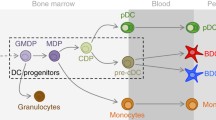Summary
On light microscopical (LM) level dendritic cells (DC) isolated from lymphoid organs can be discriminated from macrophages (Mø) by the presence of acid phosphatase (APh) activity in a spot near the nucleus and constitutional expression of class II antigens. The aim of our study was to investigate whether DC and monocytes (Mo) enriched from human peripheral blood could be discriminated on the electron microscopical (EM) level. Therefore we developed a triple method by which we compared the presence of myeloperoxidase (MPO) containing vesicles, the localization of APh containing vesicles and expression of MHC class II and RFD1 (a DC-associated class II-like antigen) plasmamembrane antigens. DC, functionally characterized as potent stimulators in a MLR, are MPO-negative, whereas Mo show MPO in cytoplasmic granules. Although both DC and Mo show little APh activity at LM level, both types of cells show APh activity at the EM level but at different locations. In DC APh containing vesicles are present in a distinct juxtanuclear area, in contrast to Mo, which show APh activity in lysosomes scattered throughout the whole cytoplasm. Moreover, on both LM and EM level, DC are strongly class II positive, whereas Mo show variable labelling intensity for class II, while RFD1 was only found on DC.
Similar content being viewed by others
References
Arkema JMS, Broekhuis-Fluitsma DM, Laat PAJM de, Hoefsmit ECM (1990) Human peripheral blood dendritic cells concentrate in contrast to monocytes intracellular class II molecules in a juxtanuclear position. Immunobiology 181:335–345
Beelen RHJ, Bos HJ, Kamperdijk EWA, Hoefsmit ECM (1989) Ultrastructure of monocytes and macrophages. In: Zembala M, Asherson GL (eds) Human monocytes. Academic Press, London, pp 7–16
Bofill M, Janossy G (1989) The reactivity of macrophages and interdigitating cells with the fourth workshop mAb. In: Knapp W, Dörken B, Gilks WR, Rieber EP, Schmidt RE, Stein H, Borne AEGKr von dem (eds) Leucocyte typing IV. White cell differentiation antigens. Oxford University Press, Oxford, pp 916–917
Bos HJ, Keizer GD, Muijsenberg AJC van de, Beelen RHJ (1990) HLA-Dr expression on human peritoneal macrophages in vivo and in vitro. Cell Biol Int Rep 14:499–508
Donermeyer DL, Allen PM (1989) Binding to Ia protects an immunogenic peptide from proteolytic degradation. J Immunol 142:1063–1068
Gaudernack G, Bjercke S (1985) Dendritic cells and monocytes as accessory cells in T-cell responses in man. I. Phenotypic analysis of dendritic cells and monocytes. Scand J Immunol 21:493–500
Heuser JE (1989) Changes in lysosome shape and distribution correlated with changes in cytoplasmic pH. J Cell Biol 108:855–864
Hoefsmit ECM, Hulstaert CE, Kalicharan D, Eestermans IL (1986) Phosphatase cytochemistry with cerium as trapping agent. Verification of acid phosphatase and glucose 6-phosphatase reactive sites. Histochemistry 84:329–332
Inaba K, Steinman RM (1986) Accessory cell-T lymphocyte interactions. Antigen-dependent and antigen-independent clustering. J Exp Med 163:247–261
Kabel PJ, Haan-Meulman M de, Voorbij HAM, Kleingeld M, Knol EF, Drexhage HA (1989) Accessory cells with a morphology and marker pattern of dendritic cells can be obtained from elutriator-purified blood monocyte fractions. An enhancing effect of metrizamide in this differentiation. Immunobiology 179:395–411
Kamperdijk EWA, Kapsenberg ML, Berg M van den, Hoefsmit ECM (1985) Characterization of dendritic cells, isolated from normal and stimulated lymph nodes of the rat. Cell Tissue Res 242:469–474
Kamperdijk EWA, Verdaasdonk MAM, Beelen RHJ (1987) Visual and functional expression of Ia-antigen on macrophages and dendritic cells in ACI/Ma1 rats. Transplant Proc XIX:3024–3028
Kapsenberg ML, Teunissen MBM, Stiekema FEM, Keizer HG (1986) Antigen-presenting cell function of dendritic cells and macrophages in proliferative T cell responses to soluble and particulate antigens. Eur J Immunol 16:345–350
Knight SC (1984) Veiled cells-dendritic cells of the peripheral lymph. Immunobiology 168:349–361
Knight SC, Farrant J, Bryant A, Edwards AJ, Burman S, Lever A, Clarke J, Webster ADB (1986) Non-adherent, low-density cells from human peripheral blood contain dendritic cells and monocytes, both with veiled morphology. Immunology 57:595–603
McCoy KL, Schwartz RH (1988) The role of intracellular acidification in antigen processing. Immunol Rev 106:129–147
O'Brien J, Knight SC, Quick NA, Moore EH, Platt AS (1979) A simple technique for harvesting lymphocytes cultured in Terasaki plates. J Immunol Methods 27:219–223
Pearse AGE (1968) Histochemistry: theoretical and applied, vol I, 3rd edn. Churchill Livingstone, Edinburgh
Poulter LW, Campbell DA, Munro C, Janossy G (1986) Discrimination of human macrophages and dendritic cells by means of monoclonal antibodies. Scand J Immunol 24:351–357
Rhodes JM, Balfour BM, Blom J, Agger R (1989) Comparison of antigen uptake by peritoneal macrophages and veiled cells from the thoracic duct using isotope-, FITC-, or gold-labelled antigen. Immunology 68:403–409
Steinman RM, Cohn ZA (1973) Identification of a novel cell type in peripheral lymphoid organs of mice. I. Morphology, quantitation, tissue distribution. J Exp Med 137:1142–1162
Steinman RM, Nussenzweig MC (1980) Dendritic cells: features and functions. Immunol Rev 53:127–147
Unanue ER, Beller DI, Lu Chr Y, Allen PM (1984) Antigen presentation: comments on its regulation and mechanism. J Immunol 132:1–5
Van Voorhis WC, Hair LS, Steinman RM, Kaplan G (1982) Human dendritic cells, enrichment and characterization from peripheral blood. J Exp Med 155:1172–1187
Van Voorhis WC, Steinman RM, Hair LS, Luban LS, Witmer MD, Koide S, Cohn ZA (1983) Specific anti-mononuclear phagocyte antibodies: application to the purification of dendritic cells and the tissue localization of macrophages. J Exp Med 158:126–145
Author information
Authors and Affiliations
Rights and permissions
About this article
Cite this article
Arkema, J.M.S., Schadee-Eestermans, I.L., Beelen, R.H.J. et al. A combined method for both endogenous myeloperoxidase and acid phosphatase cytochemistry as well as immunoperoxidase surface labelling discriminating human peripheral blood-derived dendritic cells and monocytes. Histochemistry 95, 573–578 (1991). https://doi.org/10.1007/BF00266744
Accepted:
Issue Date:
DOI: https://doi.org/10.1007/BF00266744




